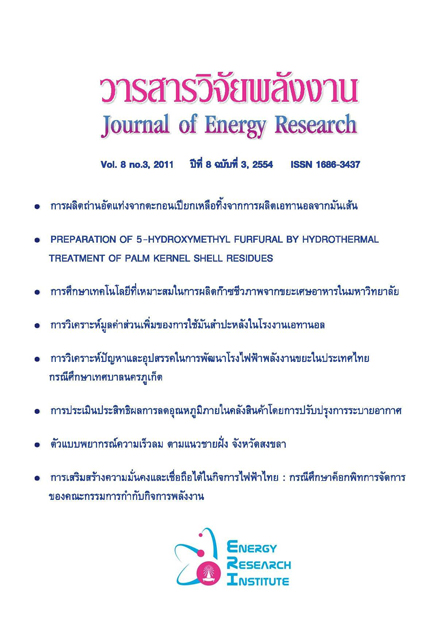การเสริมสร้างความมั่นคงและเชื่อถือได้ในกิจการไฟฟ้าไทย : กรณีศึกษาค็อกพิทการจัดการของคณะกรรมการกำกับกิจการพลังงาน
Main Article Content
Abstract
บทความนี้เสนอแนวคิดและแนวทางการปรับปรุงระบบค็อกพิทของสำนักงานคณะกรรมการกำกับกิจการพลังงาน (สกพ.) ตามหลักการค็อกพิทการจัดการ เพื่อให้คณะกรรมการกำกับกิจการพลังงาน (กกพ.) ใช้เป็นเครื่องมือในการบริหารนโยบายด้านการเสริมสร้างความมั่นคงและเชื่อถือได้ในกิจการไฟฟ้าไทยได้อย่างมีประสิทธิผล แนวทางการออกแบบพิจารณาจากแผนยุทธศาสตร์การกำกับกิจการพลังงาน ที่มีการกำหนดเป้าประสงค์เชิงยุทธศาสตร์ ตัวชี้วัดการดำเนินงาน รวมถึงกลยุทธ์หลักที่ใช้ดำเนินการ ผนัง (Wall) สำหรับแสดงผล กำหนดไว้ทั้งสิ้น 5 ผนัง จำแนกตามประเด็นสำคัญที่ใช้ขับเคลื่อนยุทธศาสตร์การกำกับกิจการพลังงาน 5 ด้าน ได้แก่ ด้านมาตรฐานกิจการพลังงาน ด้านประสิทธิภาพกิจการพลังงาน ด้านการบริหารจัดการและการแข่งขันในกิจการพลังงาน ด้านการส่งเสริมการมีส่วนร่วมของผู้ใช้พลังงาน และด้านการพัฒนาองค์กรให้มีคุณภาพ ในส่วนของมุมมอง ได้กำหนดเป็นกลยุทธ์หลัก หรือวิธีดำเนินการ โดยข้อมูลภายในกรอบ แสดงค่าตัวชี้วัดในยุทธศาสตร์การกำกับกิจการพลังงาน หรือข้อมูลสำคัญของยุทธศาสตร์นั้นๆ ผลที่ได้ นอกจากทำให้การรวบรวมข้อมูล การวิเคราะห์ และการแสดงผลเป็นระบบมากขึ้นแล้ว ยังสามารถนำแนวคิดไปต่อยอดจัดทำระบบค็อกพิทสำหรับการบริหารงานด้านอื่นๆ ของ สกพ.ต่อไป
Security and reliability enhancement of Thailand’s electricity supply industry: A case study of Management Cockpit at Energy Regulatory Commission
This paper presents the concepts and guidelines for cockpit improvement of Office of the Energy Regulatory Commission (OERC) of Thailand, employing the principles of Management Cockpit so that the Energy Regulatory Commissioner (ERC) can use it as an effective means for monitoring the security and reliability policy administration. The design is based primarily on the ERC’s strategic plan in which it contains the strategic goals, the key performance indices (KPI), and the main strategies for operation. There are five walls to display the information classified by key driving forces of regulatory strategies, which are: energy industry standards, efficiency, administration and competition, end-use participation, and organization development. The corresponding views for each strategy or method are shown in the forms of KPI and relevant important information. The outcome will lead to more systematic data collection, analysis and presentation, as well as to further development of cockpit system for managing other administrative aspects of ERC.

